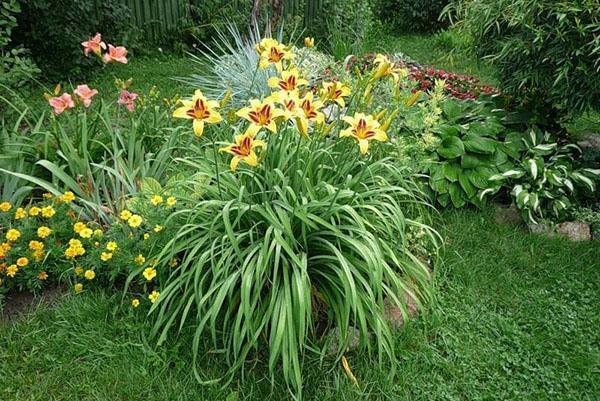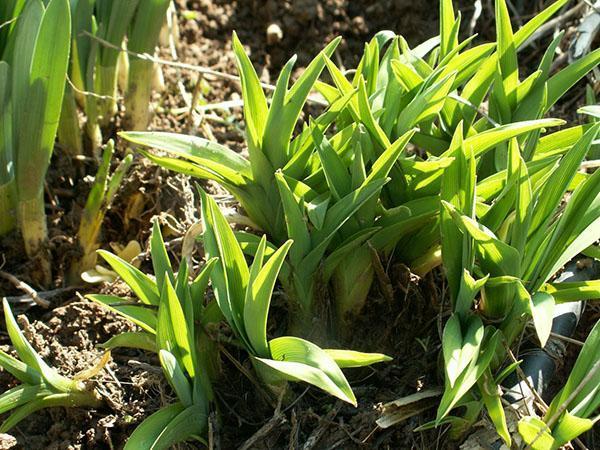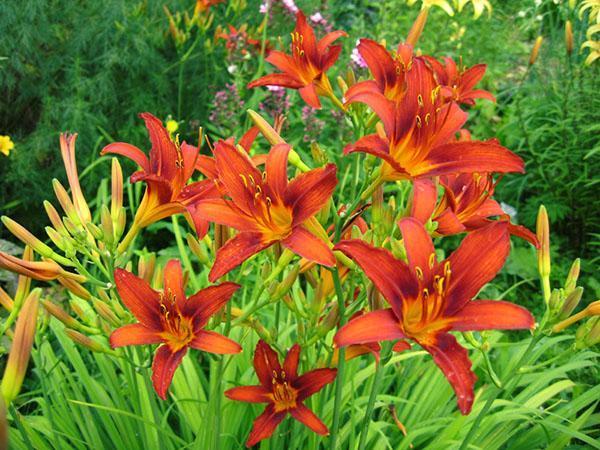Planting and care in the open field in the country for daylilies
 Among flower growers, daylilies are rightfully considered one of the most unpretentious and grateful perennials. If the garden is decorated with daylilies, planting and caring for them in the open field will clearly not be a burden to the owner of the site.
Among flower growers, daylilies are rightfully considered one of the most unpretentious and grateful perennials. If the garden is decorated with daylilies, planting and caring for them in the open field will clearly not be a burden to the owner of the site.
Plants that love the sun feel good in partial shade, the main thing is that the plants are actively illuminated for at least 6 hours. Daylilies do not impose special requirements on the composition of the soil and can grow and bloom for many years in one place, forming dense lush clumps.
Still, how do you create the best growing conditions for these spectacular flowers? When to plant daylilies outdoors in spring or fall? How to care for plants at different times of the year? Read also: host flower - photo and description!
Place for planting daylilies in the ground in spring

Experienced flower growers advise planting light varieties of daylilies in more illuminated places, and for purple, red, multi-colored varieties, for which color saturation is important, look for areas with slight shading.
To simplify the care of daylilies after planting them in open ground, places are chosen for plants that are not flooded in spring. In summer, the powerful rhizomes of plants should not suffer from the close occurrence of groundwater.
The best time to plant daylilies on the site
 Daylilies are a kind of centenarians. The most beautiful flowers, forming curtains decorated with multi-colored corollas, they can grow up to one and a half decades without transplanting. This should be taken into account when choosing a place for plants in the garden, and also know that the maximum flowering will be only 5-7 years. Then peduncles among dense foliage appear less often, and the flowers on them are much smaller than before. Therefore, the plants are transplanted every few years, dividing adult perennials.
Daylilies are a kind of centenarians. The most beautiful flowers, forming curtains decorated with multi-colored corollas, they can grow up to one and a half decades without transplanting. This should be taken into account when choosing a place for plants in the garden, and also know that the maximum flowering will be only 5-7 years. Then peduncles among dense foliage appear less often, and the flowers on them are much smaller than before. Therefore, the plants are transplanted every few years, dividing adult perennials.
An unpretentious culture easily tolerates this procedure from early spring to autumn. But planting daylilies in the ground in the spring always goes without complications, the cuttings quickly take root and grow, blooming in the same season.
Spring weather is changeable, and if there is a danger of frost, it is better to postpone planting. The planting material acquired or obtained after dividing its own plants can be stored for about a month by digging the root system of the plant into sand, peat-sandy substrate, or shifting with a damp cloth. At the same time, the leaf plates of daylilies are cut in half or a third to reduce the plant's need for moisture.
If the summer is not hot, and for daylilies, when planting in the ground, like in spring, you can really create comfortable conditions, nothing prevents you from decorating the garden until autumn. But with an autumn planting, there is a risk that the plants will not have time to root well, and the next year, if they survive, they will be very weakened.
How to plant daylilies in spring
 Before transferring seedlings to the garden, they need to be prepared for planting:
Before transferring seedlings to the garden, they need to be prepared for planting:
- Daylily strips are examined, damaged, dry or rotten roots are removed.
- The sections are treated with charcoal or activated carbon, crushed to a powder consistency.
- If this is not done earlier, the foliage is cut 10-15 cm above the base of the leaf plates.
Often, planting material purchased in a store has dried up by the time the daylily is planted in open ground, and care for such a plant begins with a 4-hour soaking of the root system in a growth stimulator.
The place has been chosen, the planting material is waiting to be transferred to the ground. It remains only to prepare a suitable soil for daylilies and start planting. Ornamental perennials prefer a loose, light substrate with a neutral or slightly acidic reaction.
 Before planting daylilies in the spring, the soil at their future place of residence must be dug up onto a full bayonet of a shovel. Next, make a planting hole sufficient to accommodate the rhizomes. For more convenience:
Before planting daylilies in the spring, the soil at their future place of residence must be dug up onto a full bayonet of a shovel. Next, make a planting hole sufficient to accommodate the rhizomes. For more convenience:
- a cone from a loosened substrate is poured at the bottom;
- a plant is placed on top of the ground;
- rhizomes are carefully laid out on the soil;
- sprinkle the underground part of the daylily with soil so that the root collar does not sink more than a couple of centimeters.
 After planting is complete, the soil around is tamped a little, and the daylily is watered.
After planting is complete, the soil around is tamped a little, and the daylily is watered.
To reduce evaporation of moisture, the soil under the plants can be mulched using any available means, for example, rotted bark or needles, straw or specialized material.
Daylily care after planting in open ground
 Regular care of plants after planting consists of watering, loosening the soil and removing weeds.
Regular care of plants after planting consists of watering, loosening the soil and removing weeds.
In the warm season, actively growing and flowering perennials require a lot of water. If daylilies are thirsty, this can be seen by faded foliage, refusal to form, or dropping buds. Perennials respond well to additional humidification in summer.
Therefore, daylilies can be planted near water bodies or use very shallow sprinkling:
- In hot weather, daylilies are watered abundantly, so that the soil under them is 20-30 cm wet, that is, to the depth of the root system.
- If the summer is not hot, you can reduce the frequency of watering, but you need to monitor the standing of the foliage.
The best time to water daylilies is early morning or evening, when there is no risk of sunburn on the flowers.
With proper planting and care, the flowers of daylilies, as in the photo, appear in the same summer. In the first year, the plants are not additionally fed. The introduction of complex fertilizers for flowering ornamental crops begins next spring. When choosing a product, it is better to give preference to formulations with a moderate nitrogen content, causing foliage to proliferate to the detriment of flowering. During the summer, perennials are fed twice, and closer to autumn, the plants receive potassium-phosphorus fertilizers for better preparation for winter.
Plants are hardy, but may suffer when there is too little snow on the site. Therefore, in snowless winters, daylilies are best covered with spruce branches, needles, straw and other materials at hand. As soon as the massive melting of the snow begins, the daylilies are released, otherwise pret develops on the root collars of plants.